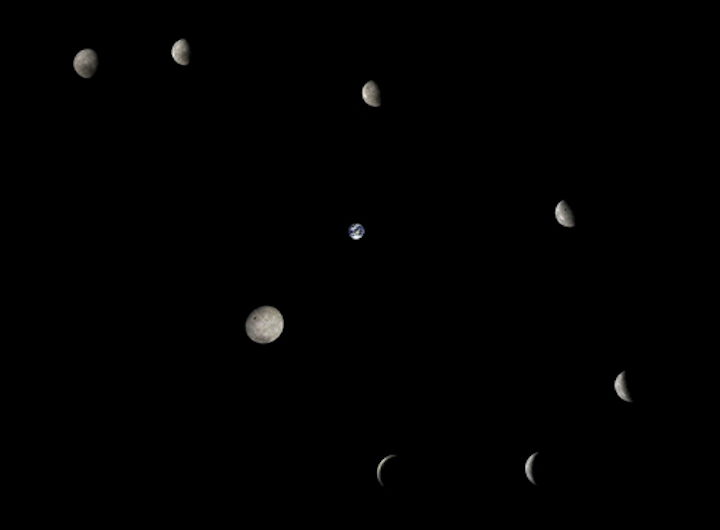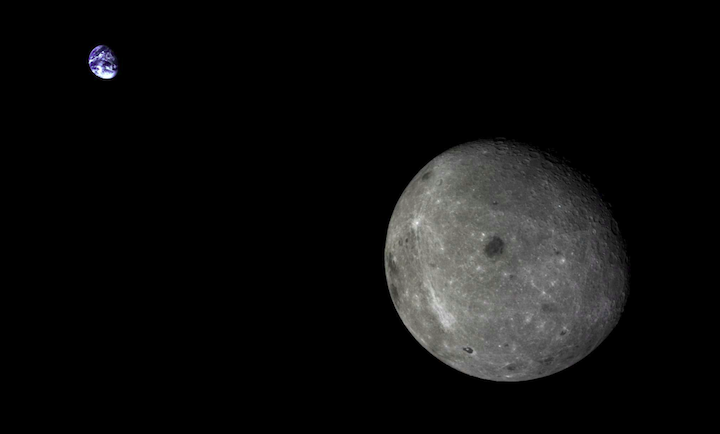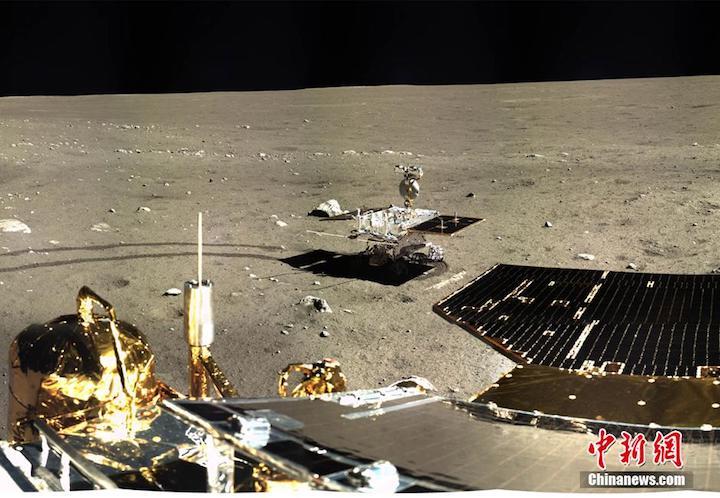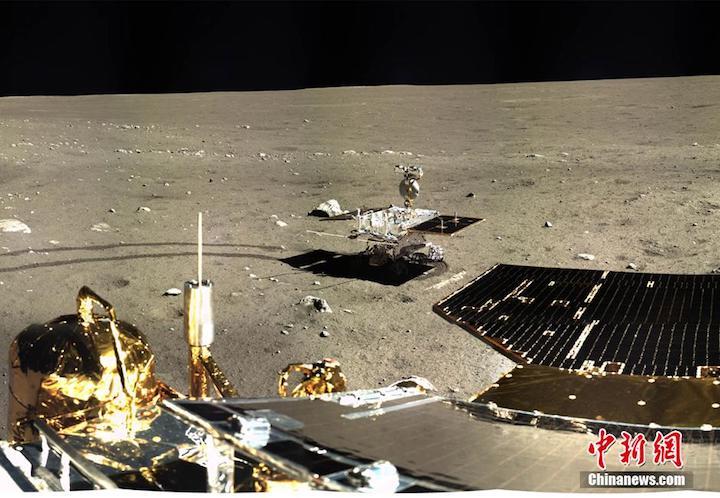A view of Mare Imbrium from China's Chang'e-3 lander. Chinese Academy of Sciences
Quelle: gbtimes
---
Update: 12.04.2018
.
Flowers on the Moon? China's Chang'e-4 to launch lunar spring
China's Chang'e-4 lunar probe is expected to do many things unprecedented in space history after it launches later this year, such as touching down softly on the far side of the Moon and taking the first flowers to blossom on the lifeless lunar surface.
The probe will carry a tin containing seeds of potato and arabidopsis, a small flowering plant related to cabbage and mustard, and probably some silkworm eggs to conduct the first biological experiment on the Moon.
The "lunar mini biosphere" experiment was designed by 28 Chinese universities, led by southwest China's Chongqing University, a conference on scientific and technological innovation of Chongqing Municipality has heard.
The cylindrical tin, made from special aluminum alloy materials, is 18 cm tall, with a diameter of 16 cm, a net volume of 0.8 liters and a weight of 3 kilograms. The tin will also contain water, a nutrient solution, air and equipment such as a small camera and data transmission system.
Researchers hope the seeds will grow to blossom on the Moon, with the process captured on camera and transmitted to Earth.
Although astronauts have cultivated plants on the International Space Station, and rice and arabidopsis were grown on China's Tiangong-2 space lab, those experiments were conducted in low-Earth orbit, at an altitude of about 400 kilometers. The environment on the Moon, 380,000 kilometers from the Earth, is more complicated.
Liu Hanlong, chief director of the experiment and vice president of Chongqing University, said since the Moon has no atmosphere, its temperature ranges from lower than minus 100 degrees centigrade to higher than 100 degrees centigrade.
"We have to keep the temperature in the 'mini biosphere' within a range from 1 degree to 30 degrees, and properly control the humidity and nutrition. We will use a tube to direct the natural light on the surface of Moon into the tin to make the plants grow," said Xie Gengxin, chief designer of the experiment.
"We want to study the respiration of the seeds and the photosynthesis on the Moon," said Liu.
"Why potato and arabidopsis? Because the growth period of arabidopsis is short and convenient to observe. And potato could become a major source of food for future space travelers," said Liu. "Our experiment might help accumulate knowledge for building a lunar base and long-term residence on the Moon."
The public, especially young people, are being encouraged to participate in the Chang'e-4 mission. The China National Space Administration (CNSA) launched a contest among students across China in 2016, collecting ideas on the design of the payloads.
The "lunar mini biosphere" experiment was selected from more than 200 submissions, according to the CNSA.
Tidal forces of the Earth have slowed the Moon's rotation to the point where the same side always faces the Earth, a phenomenon called tidal locking. The other face, most of which is never visible from the Earth, is the far side of the Moon.
With its special environment and complex geological history, the far side is a hot spot for scientific and space exploration. However, landing and roving there requires a relay satellite to transmit signals.
It has been reported that China plans to send a relay satellite for Chang'e-4 to the halo orbit of the Earth-Moon Lagrange Point L2 in late May or early June 2018, and then launch the Chang'e-4 lunar lander and rover to the Aitken Basin of the south pole region of the Moon about half a year later.
The Von Karman Crater, named after a Hungarian-American mathematician, aerospace engineer and physicist, in the Aitken Basin, was chosen as the landing site for Chang'e-4. The region is believed to have great scientific research potential.
The transmission channel is limited, and the landscape rugged, so the mission will be more complicated than Chang'e-3, China's first soft landing on the Moon in 2013, said Liu Tongjie, deputy director of the Lunar Exploration and Space Program Center of CNSA.
As the relay satellite will be sent to the Earth-Moon Lagrange Point L2 about 450,000 kilometers from the Earth, where a gravitational equilibrium can be maintained, it could stay in stable orbit and operate for a long time.
"We will make efforts to enable the relay satellite to work as long as possible to serve other probes, including those from other countries," said Ye Peijian, a leading Chinese aerospace expert and consultant to China's lunar exploration program.
The Lunar Exploration and Space Program Center of the CNSA has invited the public to write down their hopes for lunar and space exploration, and those hopes and the names of participants will be carried by the relay satellite into deep space. More than 100,000 people have taken part, according to the center.
Quelle: Xinhua
+++
Chang'e-4 relay satellite to be named through contest held by space science centre

The Earth and Moon seen from Earth-Moon L2 by the C5-T1 service module. Chang'e-4 will use a relay satellite deployed in at L2 to provide communication with the far side lunar lander and rover. SASTIND
-
A competition has been opened to name the communications relay satellite that will soon launch to facilitate the pioneering Chang'e-4 lunar far side landing mission in late 2018.
The Chang'e-4 relay satellite is a necessary part of a lunar far side landing mission, as that area of the Moon never faces the Earth. The satellite will be be placed at a Lagrange Point beyond the Moon to provide a communications link between the lunar lander and rover and Earth.
The National Space Science Centre (NSSC) under the Chinese Academy of Sciences (CAS) last month launched (Chinese) the naming contest for the satellite, running from March 27 to April 15.
The winning entry will be announced on China's third annual Space Day, on April 24.

Image demonstrating a halo orbit around the second Earth-Moon Lagrange point, from which the Chang'e-4 communications relay satellite will operate. NAOC/CAS
Unlike a recent, prior contest for sending messages aboard the relay satellite, the naming competition is only open to a select number of institutes and universities close to the mission.
In March, China's General Office of Lunar and Deep-space Exploration selected nearly 8,000 names and messages to travel along with the relay satellite, from over 120,000 submitted. Three lucky winners were also chosen(Chinese) to travel to see the launch.
The relay satellite is expected to launch in May or June from the Xichang Satellite Launch Centre in the southwestern province of Sichuan, carried by a Long March 4C rocket.

Preparations for the November 2017 launch of the Beidou-3 M1 and M2 satellites via Long March 3B from Xichang, Sichuan Province. beidou.gov.cn
China has been increasingly using such contests to boost public awareness of and participation in space missions, including the naming of the 2013 Chang'e-3 rover, 'Yutu', or Jade Rabbit, and the 2020 Mars mission.
Another Chang'e-4 competition, launched in 2016, saw students across China submit ideas for a science payload, with a lunar mini biosphere experiment, containing silkworm eggs and potato seeds, being selected.

The far side of the Moon and the distant Earth, imaged by the Chang'e-5T1 mission in 2014. Chinese Academy of Sciences
Lunar microsatellite companions
The upcoming launch will also be carrying a pair of microsatellites, unofficially named DSLWP-A1 and DSLWP-A2, which will be placed in lunar orbit to test low frequency radio astronomy and space-based interferometry.
They will be equipped with low frequency antennae to observe the sky at the very low frequency part of the electromagnetic spectrum with the aim of learning about energetic phenomena from celestial sources.
DSLWP-A2 will carry a microcamera developed by the King Abdulaziz City for Science and Technology (KACST) of Saudi Arabia, one of the four international partners providing payloads for the Chang'e-4 mission.

Testing on the Chang'e-4 DSLWP-A1 and DSLWP-A2 microsatellites in early 2018. CCTV/Youtube/Framegrab
Sweden, Germany and the Netherlands are all also involved in the mission, providing Chang'e-4 payloads.
The Chang'e-4 lander and rover, using the backup spacecraft from Chang'e-3, have meanwhile been undergoing thermal vacuum and other space environment tests in preparation for launch around November or December this year.
For latest news and developments on the mission, see our feature on China's Chang'e-4 mission to the far side of the Moon

The Chang'e-3 lander on Mare Imbrium, imaged by the Yutu rover. Chinese Academy of Sciences
Quelle: gbtimes
---
Update: 20.04.2018
.
China to name relay satellite for Chang'e-4 lunar probe
China will give a name to the relay satellite for the Chang'e-4 lunar probe, which is expected to land softly on the far side of the Moon in late 2018.
The name will be announced on China's Space Day on April 24, marking the day the country's first satellite was sent into space in 1970, according to the China National Space Administration (CNSA).
Together with the relay satellite, two microsatellites, developed by the Harbin Institute of Technology, will also be sent into orbit to conduct scientific research. The names of the two microsatellites will also be announced on April 24.
The development of the Chang'e-4 lunar probe is progressing well, said Li Guoping, a spokesman of CNSA.
The Chang'e-4 probe will also carry scientific payloads developed by the Netherlands, Sweden, Germany and Saudi Arabia.
Tidal forces of the Earth have slowed the Moon's rotation to the point where the same side always faces Earth. The other face, most of which is never visible from Earth, is the far side of the Moon.
With its special environment and complex geological history, the far side is a hot spot for scientific and space exploration. However, landing and roving there require a relay satellite to transmit signals.
According to previous reports, China plans to send the relay satellite to the halo orbit of the Earth-Moon Lagrange Point L2 in late May or early June 2018, and then launch the Chang'e-4 lunar lander and rover to the Aitken Basin of the south pole region of the Moon about half a year later.
Quelle: Xinhua
---
Update: 2.06.2018
.
Queqiao update: Chang'e-4 lunar relay satellite establishing halo orbit after approaching Lagrange point

It has been a week since the Queqiao Chang'e-4 lunar relay satellite made its lunar swing-by, sending it on a transfer trajectory towards the second Earth-Moon Lagrange Point (EML2). There have been no official updates from China, so where is the spacecraft now?
Having launched late on May 20 UTC, Queqiao made its lunar swing-by on May 25, performing a braking burn at 13:32 UTC to send the communications satellite towards EML2, some 60-80,000 km beyond the Moon.
EML2 is one of five libration points in the Earth-Moon system that allow a much smaller third body to orbit while maintaining its position relative to the larger two, making it a perfect place for Queqiao to perform its main objective.
Queqiao should have approached the EML2 point by May 29 after two orbital corrections, but no updates have come from China. This has brought confusion, but making the distinction between reaching EML2 and establishing the desired orbit around it helps bring clarity.
On approaching EML2, assuming all is well, Queqiao will have begun manoeuvres required to obtain a halo orbit (or more accurately a Lissajous orbit shown below) around EML2 with a radius sufficient to allow it constant line of sight with both tracking stations on the Earth and the lunar far side, on which a lander and rover are planned to set down in late 2018.

A demonstration of the Lissajous/halo orbit to be used by the Queqiao Chang'e-4 relay satellite mission. CASC
According to the illustration below - showing the planned trajectory, manoeuvres and orbit for Queqiao - the spacecraft will have made a gravitational capture manoeuvre around May 29 to begin a 15-day segment of its journey to obtain a halo orbit around EML2, which is its mission orbit.
This fits with the preliminary flight profile design outlined in an article published in Science China - Technological Sciences in 2017 titled An Overview of the Mission and Technical Characteristics of Change’4 Lunar Probeauthored by senior figures from the China Academy of Space Technology (CAST) and the Institute of Spacecraft System Engineering in Beijing.

A chart laying out the trajectories for the Queqiao Chang'e-4 lunar relay satellite to obtain a halo orbit around the second Earth-Moon Lagrange point.
The paper outlined three transfer options for arriving at EML2, with the lunar swing-by chosen over direct and low-energy transfers. The flight profile outlines that the spacecraft will make three orbital corrections after the EML2 capture phase to establish the halo orbit.
According to the outlined schedule, the halo orbit may not be obtained until mid-June, which may also be the next time we get an official Queqiao mission update. Hopefully this will include images from the onboard cameras.
We are also awaiting an update on the status of the one of two microsatellites (Longjiang-1/-2 or DSLWP-A/B) launched along with Queqiao. While Longjiang-2 successfully entered an elliptical lunar orbit, there has been silence from Longjiang-1.

The Longjiang-1 and -2 (aka DSLWP-A/B) microsatellites launched to the Moon with the Queqiao Chang'e-4 lunar relay satellite on May 20 UTC, 2018. Harbin Institute of Technology
Landing, astronomy and...sample return?
Queqiao is expected to be able to operate in this orbit for at least three years, with the fuel requirement for station keeping at EML2 being relatively low. It will use a 4.2 m diameter parabolic antenna and s- and x-band frequencies to facilitate data relay between the Earth and far side of the Moon.
The lander and rover for the mission, to be launched on a Long March 3B from Xichang in November or December, in March underwent thermal vacuum testing, which are the last of a range of space environment tests which began in January before the Chang'e-4 spacecraft can leave the Assembly, Integration and Testing (AIT) Centre.
After the initial landing and roving section of the mission, with the rover designed to operate for at least three months, a low-frequency radio astronomy antenna, NCLE, will be deployed to determine the activity in the solar system at frequencies between 1-30 MHz, and eventually attempt to detect a signal from the cosmic 'Dark Ages'.
The relay satellite could facilitate future international missions, or a lunar far side sample return with Chang'e-6, should the 2019 near side Chang'e-5 sample return mission be successful.
China's Chang'e-3 lander and Yutu (Jade Rabbit) rover operating on the Moon after landing in late 2013.
Quelle: gbtimes


















